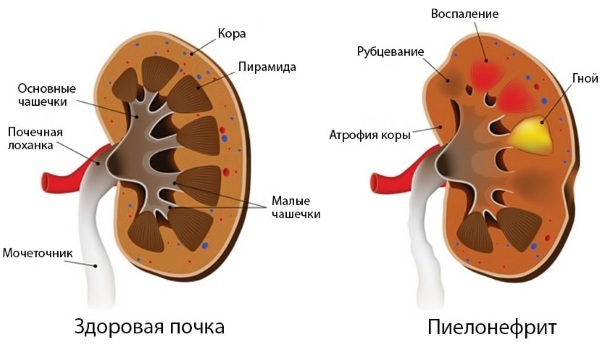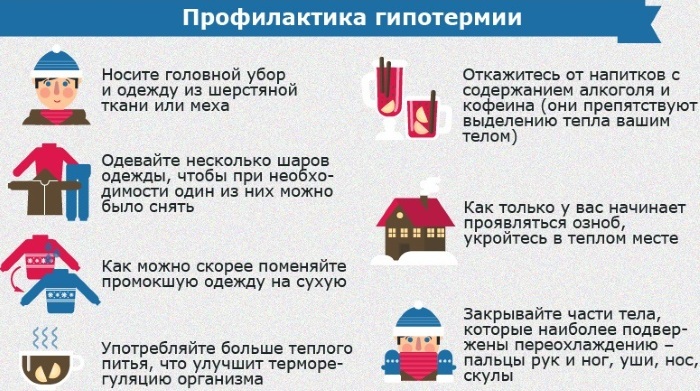Chlorine - aggressive chemical element. It is used for disinfection and antiseptic treatment of surfaces, containers, and much more. You can breathe in bleach at home. What to do in this case depends on the degree of poisoning.
Record content:
- 1 Chemical properties
- 2 How dangerous are chlorine vapors?
- 3 How does chlorine poisoning happen?
- 4 Symptoms and signs of poisoning
- 5 The main stages of poisoning
- 6 First aid for poisoning
- 7 When is medical attention required?
- 8 Possible consequences of chlorine entering the body
- 9 Treatment
- 10 Tips for expectant mothers
- 11 Chlorine poisoning video
Chemical properties
Chlorine in solid, liquid and gaseous form is a part of household chemicals and detergents. This substance is classified as a biogenic element in the halogen category. Chlorine ions are present in the human body in microscopic quantities.
They perform a number of important biological functions:
- maintain a normal level of osmotic pressure;
- regulate water-salt balance;
- control the activity of nerve fibers;
- create proper conditions for the biochemical activity of gastric acid enzymes;
Chlorine is extremely toxic. The safe daily allowance is 0.8 g. The chlorine balance in the human body is replenished mainly due to the consumption of table salt.
This gas in its pure form has a greenish-yellow tint, a pungent unpleasant odor and a metallic taste. It dissolves easily in water and organic liquids.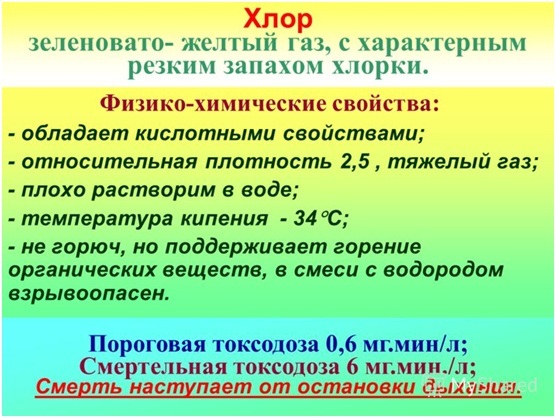
This gas is irritating and suffocating. It was part of the 1st generation chemical warfare agents. Chlorine easily passes from a gaseous state to a liquid and solid. Therefore, the scope of its domestic and industrial applications is extremely wide.
I breathed in bleach (it is necessary to decontaminate the body only with a significant degree of poisoning) - a problem mainly affecting women who often use this substance for home cleaning.
In a liquid state, toxic halogen is highly corrosive, destroying the surface structure of metals.
It is used for:
- production of natural and synthetic insecticides;
- manufacturing of plastics;
- bleaching of fabrics;
- production of polymer fibers;
- disinfection of drinking water.
Due to its high toxicity, the substance is included in many chemical solvents.
How dangerous are chlorine vapors?
A significant concentration of chemically aggressive halogen in the body leads to the destruction of cellular structures and tissues. Vapors of this gas burn the respiratory tract, cause spasm of the bronchial tree and other organs of the respiratory system.
They have a suffocating effect. When chlorine vapor is inhaled, bronchial spasm is observed, which is manifested by the difficulty in accessing the air mixture to the lungs, severe coughing and shortness of breath. There is a chemical burn of the walls of the respiratory tract.
A large volume of chlorine vapor causes the development of the inflammatory process, and their regular effect on the respiratory system can lead to oncological changes in the cells. With severe poisoning, pulmonary tissue edema is observed.
Inhalation of chlorine vapors is especially dangerous during pregnancy. This toxic and chemically aggressive xenobiotic is capable of penetrating the placenta and causing irreversible pathological changes in the formation and development of the embryo.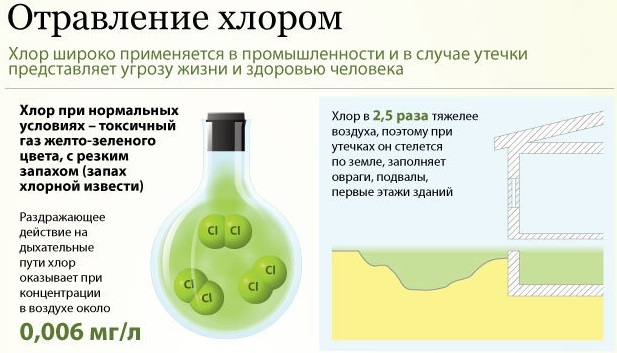
In such a physiological state, the susceptibility of the female body to any chemically aggressive and allergenic substances, including chlorine, increases. The ability of this halogen to be absorbed into breast milk has been established.
With it, chlorine enters the baby's body, causing a state of chemical intoxication. Therefore, during pregnancy and lactation, it is strongly recommended to refrain from contact with products that contain this halogen.
With oral penetration of chlorine into the body, edema of the mucous membrane of the oral cavity and upper respiratory tract is observed. This substance increases the fragility of the vascular walls, which can lead to rupture in the future.
How does chlorine poisoning happen?
The most common way of penetration of aggressive halogen into the body is the respiratory system. Chlorine, even in a liquid or solid state, evaporates intensively, especially at positive temperatures.
I breathed in bleach (you don't need to do anything with mild poisoning, you just need to go out into the fresh air) - a problem which occurs when working in a poorly ventilated room with detergents and chemicals containing this xenobiotic.
Poisoning most often occurs due to neglect of industrial safety rules or careless handling of chlorine-containing compounds in domestic conditions.
Common options for toxic halogen poisoning:
| Cause | Description |
| Swimming pool visit | Water in such sports and entertainment complexes must be disinfected with chlorine. With a poorly organized ventilation system, a large amount of toxic fumes can accumulate in the air. |
| Accidental ingestion of pesticides | Garden insecticides often contain chlorine. When processing a summer cottage without using a chemical protection suit, inhalation or ingestion of fine particles of xenobiotic is not excluded. |
| Works on disinfection of drinking liquid or water pipes | Usually, during such operations, special means of chemical protection are used. Neglect of established safety rules and non-observance of job descriptions can lead to poisoning. |
| Contact with chlorine solution on the surface of the skin | This chemically aggressive halogen easily overcomes the epidermal barrier, being absorbed into the deeper layers, tissues and bloodstreams. This situation can lead to severe poisoning. |
With prolonged contact with the skin, chlorine causes its chemical burn and the state of intoxication of the whole organism.
Symptoms and signs of poisoning
In accordance with the concentration and duration of exposure to a toxic substance on the body, there are 3 stages of chemical contamination - mild, moderate and severe. With a critically high chlorine content, a lightning-fast degree of poisoning develops.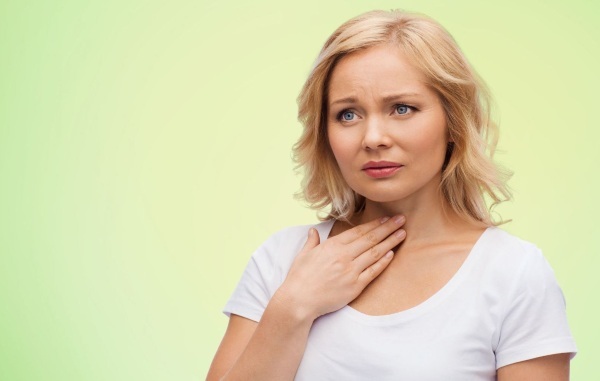
The symptomatology of chemical intoxication depends on the stage of the lesion.
In case of mild poisoning with chlorine or its fumes, the following is observed:
- hyperemia of the conjunctival membrane;
- drying out of the mucous membrane of the eyes, dental cavity and respiratory tract;
- a sore throat;
- sneezing reflex;
- dry type cough syndrome;
- profuse lacrimation;
- renorrhea - liquid discharge from the nasal cavity;
- burning in the mouth and in the periorbital zone.
With moderate chlorine poisoning, general weakness occurs, consciousness is suppressed, and the vocal cords are affected. Among the pathological signs of such a lesion is a spasm of the bronchial tree, accompanied by difficulty breathing.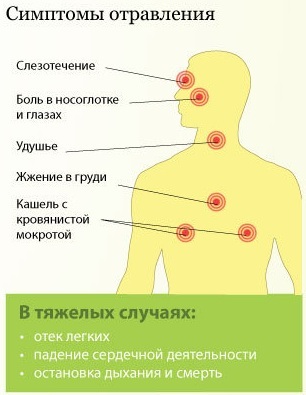
The eyeballs, sclera and eyelids swell and turn red. With the introduction of chlorine and its vapors into the digestive tract, clinical symptoms of severe poisoning are observed.
It is expressed in:
- chemical burns of the gastrointestinal mucosa;
- violation of gastric motility;
- severe pain and cramps in the esophagus;
- swelling of the larynx;
- vomiting with blood inclusions;
- increased nervous excitement;
- dark urine and difficulty urinating.
In case of severe poisoning with concentrated chlorine or its vapors, cardiac activity and dysfunction of internal organs are possible. The lesion by this substance often has a blurred clinical picture, reminiscent of the typical symptoms of anaphylactic shock.
I breathed in bleach - a condition that only a doctor can diagnose. He will tell you what to do and how to reduce the level of intoxication. A chemically aggressive substance easily overcomes the integumentary tissues of the epidermis. When working with chlorine-containing household chemists, personal safety rules must be observed.
The main stages of poisoning
There are several ways to classify lesions with this toxic substance. Only a 5-step grading based on the severity of the poisoning is of clinical significance. The rest are predominantly statistical in nature and are important for the development of preventive measures at work and at home.
According to the principle of classification according to the degree of chlorine poisoning, the following stages are distinguished in order of increasing severity of symptoms:
- Easy. It is characterized by damage by chlorine gas in a concentration of up to 0.012 g / m3. The clarity of consciousness remains, the primary symptomatology is weak or not observed at all. The victim does not need hospitalization. Signs of xenobiotic infection spontaneously disappear within 1-2 days.
- Average. The concentration of the chemical element Cl is about 0.09 g / m3. Symptoms are more pronounced, consciousness remains clear, moderate manifestations of systemic and local intoxication are observed. The victim's condition is gradually deteriorating. Symptoms disappear on their own within 3 days. Sometimes home care is required.
-
Heavy. This stage is typical for chlorine contamination at a concentration of up to 0.5 g / m3. Psychomotor agitation is growing, which, if timely medical care is not provided, can go into a coma. There are symptoms of respiratory failure, laryngospasm is observed. After 3-8 hours. after poisoning, severe edema of the pulmonary alveoli may occur. The victim must be placed in a hospital under round-the-clock medical supervision.
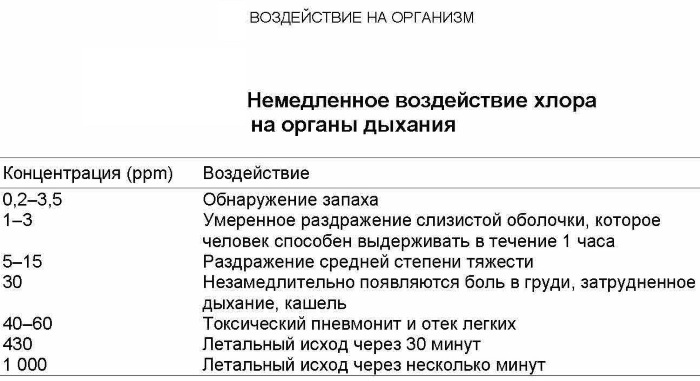
- Lethal. A lethal dose of chlorine is from 0.51 g / m3. The physiological functions of the body stop within 10-15 minutes. Respiratory spasm, which cannot be eliminated by medication, leads to oxygen starvation of the brain and cessation of cardiac activity, which leads to rapid death. A common cause of death is rapidly increasing asphyxia.
- Lightning fast. This is the most rare stage of chlorine poisoning. It is characterized by a sudden intake of a large volume of a toxic substance into the body, which leads to reflex respiratory arrest and spasm of the heart muscle.
In the lightning stage, death occurs within 1 min. In such concentrations, chlorine was previously used in chemical warfare formulations. In 98% of cases, cardiopulmonary stimulation and other resuscitation measures do not work.
First aid for poisoning
The basic rule is complete isolation of the victim from the source of infection. First aid is provided in several stages. First, ventilate the room to provide fresh air.
I breathed in bleach - you need to do wet cleaning right away in order to remove xenobiotic microparticles from the surfaces, which will prevent further infection and its transition to a more severe stage.
The sinuses are washed with a weak solution of soda. The recommended concentration is 1 tsp. l. in a glass of water. In case of moderate and severe poisoning, it is necessary to call an ambulance.
Before the arrival of the doctor, the victim can be given mineral water or milk, which has the property of neutralizing the effect of chemicals. If the eyeballs are damaged, they are instilled with olive oil.
If the infection has caused chlorine-containing liquid to enter the gastrointestinal tract, gastric lavage is performed and an absorbent drug is taken. You can drink 1 liter of salt water to activate the gag reflex.
If the victim has fallen into unconsciousness, give a sniff of cotton wool soaked in ammonia. With severe intoxication, there may be no signs of pulmonary activity and cardiac activity. In this case, artificial respiration and stimulating heart massage should be done before the arrival of the doctor.
When is medical attention required?
If you suspect severe chlorine poisoning, it is imperative to call an ambulance. Most cases of moderate xenobiotic infection also require qualified medical care.
To correctly assess the degree of intoxication of the body with a poisonous substance for an unprepared person is an extremely difficult task. In the first hours, the clinical picture is blurred and unclear. Therefore, it is advisable to place the victim under medical supervision.
This will avoid the development of dangerous complications. In case of severe poisoning, the necessary resuscitation measures will be carried out in the hospital, which will significantly reduce the development of consequences that threaten health and life.
The clinic will ensure the supply of the respiratory mixture to the organs of the respiratory system, stabilize the physiological parameters of the body, and restore hemodynamics. Under stationary conditions, it is possible to maintain basic body functions and metabolic processes blocked by the destructive activity of xenobiotics.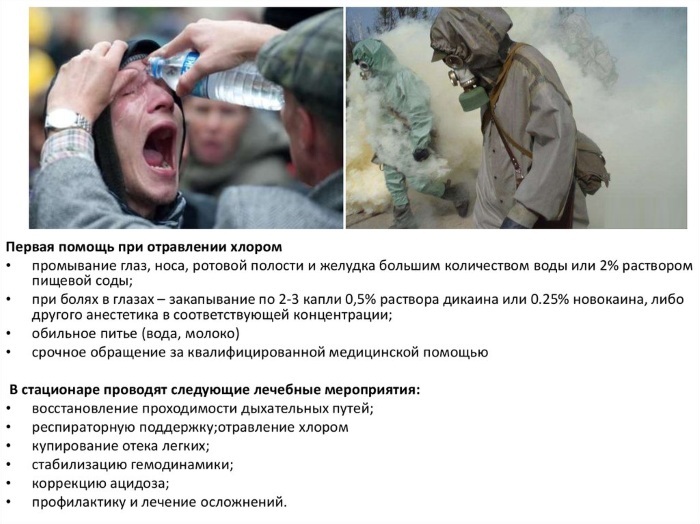
Reasons for urgent medical attention:
- sore throat;
- dizziness;
- vomit;
- burning in the eyes;
- clouding of consciousness;
- itching of the skin.
In hospitals there are all the means to eliminate the symptoms of poisoning with a toxic substance and bring the victim to a normal functional state.
Possible consequences of chlorine entering the body
A mild degree of intoxication passes without complications. It does not lead to functional disorders of the body systems.
With prolonged and intense exposure to concentrated chlorine solution, the following pathological conditions develop:
- chemical burns of the skin and mucous membranes, leaving scars and structural changes in the surface;

- allergic dermatitis, which is manifested by dryness of the epidermis, itching, redness and an inflamed condition;
- edema of the lung tissues, which can lead to respiratory arrest and death;
- bronchitis, associated with a strong dry type cough, spasm of the cavity, aching pain in the chest;
- inflammation of the trachea, which interferes with normal respiratory activity;
- laryngitis - an inflammatory process in the larynx;
- a significant drop in visual acuity, up to complete blindness.
I breathed in bleach (in case of severe poisoning, you need to massage the heart, otherwise it may stop) - a situation that can lead to other sad consequences, up to a violation of the functions of vital organs - the brain, liver, kidneys.
Inhalation of large volumes of chlorine vapor or bodily contact with a liquid solution causes the following chronic and acute pathologies:
- dystrophy of the conjunctiva;
- toxic pneumonia;
- bronchiectasis;
- pulmonary emphysema;
- decreased muscle tone;
- renal failure;
- dysfunction of the thyroid gland.
On contact with the mucous membrane, chlorine decomposes into oxygen and hydrochloric acid. The latter sharply increases the acidity of the body and blocks metabolic processes. This provokes vomiting and prevents the evacuation of toxins from the liver.
Treatment
Therapeutic measures for chlorine poisoning are carried out in a medical hospital. Antibiotics are prescribed to eliminate the inflammatory process.
In case of damage to the respiratory tract, bronchodilators are used to reduce shortness of breath and relieve the state of chemical asphyxia. Chlorine intoxication is treated with antispasmodic drugs, expectorant drugs.
They use synthetic hormones - in particular, corticosteroids, which relieve an acute condition. Physiotherapeutic procedures are prescribed - alkaline inhalations and others. Intravenous injections of calcium gluconate are recommended. Antihistamine solutions are administered intramuscularly.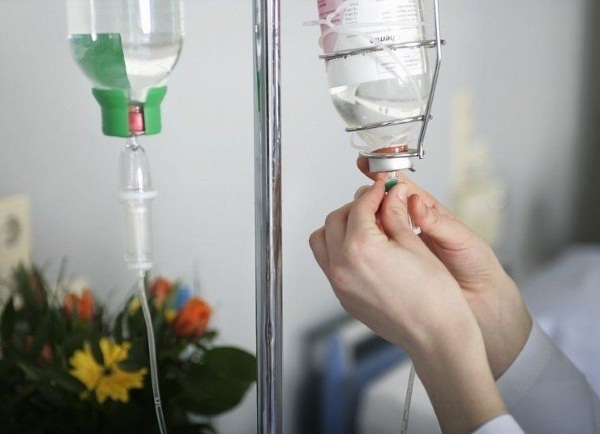
In order to restore the water-salt balance, an infusion of crystalloid medicines is prescribed. With swelling of the lung tissue, diuretic drugs are used. Albumin is prescribed as a replacement therapy.
In case of severe chlorine injury, the victim is connected to a ventilator. Some modern medical centers use magnetohematotherapy.
The blood is exposed to high-intensity ultraviolet radiation and sodium hypochlorite is infused, which is a powerful oxidant capable of decomposing chlorine in the body.
Tips for expectant mothers
There are many types of chlorine-free household detergents. However, it is hardly possible to completely abandon the use of this disinfecting substance. Even an ordinary liquid from a centralized water supply contains chlorine.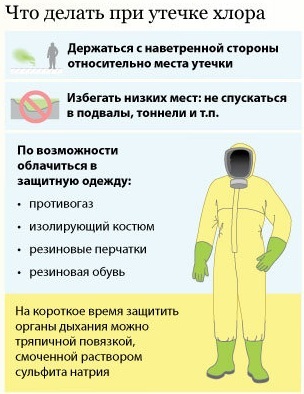
- Pregnant women are advised to use cartridge filters. It is advisable to boil water before drinking.
- For the period of bearing a child, you must refuse to visit the pool. Water there must be disinfected with a large amount of chlorine.
- For cleaning, you should try to use detergents that do not contain this toxic substance. The manufacturer always indicates the composition on the package. When working with chemically aggressive substances, rubber gloves and a protective mask must be used.
During lactation, breathing in bleach is especially dangerous for the health of the child. This chemical can pass into breast milk and negatively affect the child's body, even in small doses. What to do if the infection still occurs - until the consequences of intoxication are completely eliminated, protect the child from contact with breast milk.
Chlorine poisoning video
First aid for chlorine poisoning:

